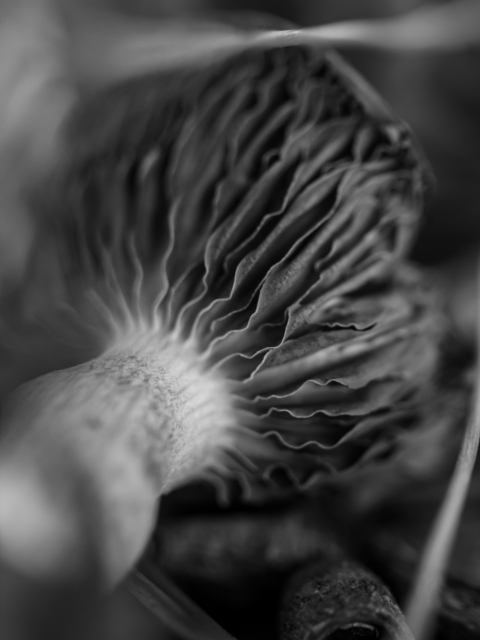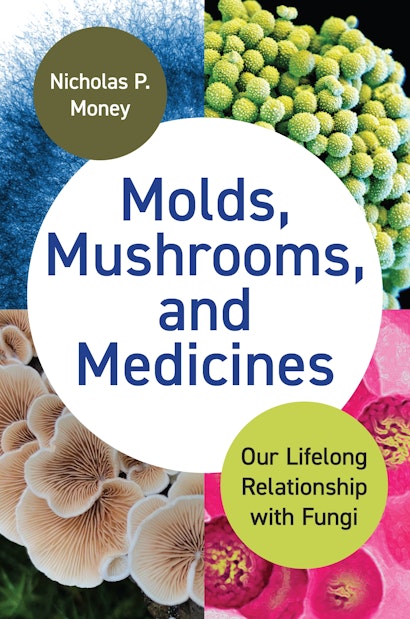This is the story of the human relationship with the fungi, from the billions of yeasts that live in the digestive system and cover our skin, to the fungi that we use as food and to produce medicines, and our dependence on mushroom colonies that sustain forests. Nicholas Money takes readers on a guided tour of a marvelous unseen realm, describing the continuous conversation between our immune systems and the teeming mycobiome inside the body, and how we can fall prey to life-threatening infections when this peaceful coexistence is disrupted. He also explores our complicated relationship with fungi outside the body, from wild mushrooms and cultivated molds that have been staples of the human diet for millennia to the controversial experimentation with magic mushrooms in the treatment of depression.
What is the big idea behind your book?
NPM: The big idea is that we are affected by fungi throughout our lives, from our fetal life in the womb, to birth, childhood, adulthood, and at the end of life. Fungi affect our bodies after death too, when their colonies participate in the decomposition of the solid tissues in the soil. The fungi are with us at every moment, in an intimate fashion as they reproduce on the skin and in the digestive system, and in an extended way when we use them as a source of food and medicines. This is an ancient relationship that has changed during our evolutionary history and intensified when we developed agricultural practices and, most recently, as we have adopted fungi in biotechnology. Our interactions with the fungi go even further when we think about our dependence on their ecological activities, including the roles of the fungi in fertilizing soils, purifying water, and supporting plants by forming mycorrhizas with their roots. I wanted to tell the whole story in this book, which has captivated me since I began working on the fungi as a graduate student in the 1980s. It is easy to dismiss the fungi as the stuff of fairy tales, but there is so much more to the deep relationship between humans and fungi.
What is one of the features of the book that you think will surprise readers?
NPM: The fast pace of discovery in medical mycology is really inspiring. Earlier generations of mycologists misunderstood the fungi that they found on the body, regarding most of them as germs that damaged hospital patients and overlooking the significance of the yeasts growing peacefully on everyone else. Even when molecular genetic techniques began to reveal the incredible diversity and number of microbes in the gut, the fungi were missed because the methods were limited to identifying the DNA sequences of bacteria. This picture is changing at last, and new investigative methods are exposing the yeasts and molds multiplying from scalp to toes on the outside of the body and from mouth to anus on the inside. As this examination of the fungi has proceeded, the vision of the microbiome as a mostly bacterial territory has shifted to an appreciation of the diverse communities of fungi that fight and cooperate with bacteria through webs of chemical interactions to make a living on the body. Through these innovations we are beginning to fathom the extraordinary influence of the mycobiome on our health and well-being.
“Appreciating the fungi … can begin with something as simple as looking at a mushroom—this beautiful oddity of nature—or inhaling the wondrous scent of a handful of rotting pine needles. There is so much beauty in this orgy of decomposition.”
What did you find most surprising when you were researching the subject of the mycobiome (the fungal part of the microbiome)?
NPM: The size of fungal cells is an esoteric detail with huge consequences. Billions of fungi, mostly yeasts, live in the gut alongside trillions of bacteria. These gut fungi weigh no more than a raisin, but their combined surface area is equivalent to an eight-person dining table. This huge area of fungal cell wall material is moving through the digestive system all the time, which may explain how the fungi punch above their weight in their effects on our health. Recent research has shown that yeasts and molds are associated with a range of illnesses in the gut ranging from inflammatory bowel disease to colorectal cancer. Although it is difficult to distinguish between cause and effect when we find changes in the numbers and types of fungi in these illnesses, some specialists are convinced that the fungi are a missing link in medicine.
What concerns you most about the future of our relationships with the fungi?
NPM: The ecological importance of the fungi, including their role in supporting plant growth and their efficiency as decomposers has led popularizers of mycology to suggest that fungi can restore logged forests, clean water polluted by oil spills, and even break down radioactive waste. These claims are unfounded, but they have convinced many young people that there are relatively simple remedies for the human impact on the biosphere. The actions of the fungi are amazing, but they will not save us from ourselves. In a similar vein, many of the assertions about the medicinal properties of mushrooms are absurd. Mycology is a field that has attracted a lot of wishful thinking, but I have always believed that the facts about the biology of the fungi are far more interesting than the fiction. This book sets the record straight.
Did anything make you laugh as you worked on this book project?
NPM: There is great humor in some of the pronouncements made by the more colorful figures who have promoted mycology in the last century. For example, Terence McKenna, who took “heroic doses” of drugs in the 1970s, declared that the psilocybin molecule found in magic mushrooms was so unusual that it must have originated elsewhere in the galaxy. He went on to postulate that psilocybin mushrooms were a higher form of intelligence that had arrived from outer space and shaped the evolution of the human brain. Although he faces some stiff competition, McKenna’s alien mushroom theory is one of the least enlightening things ever written about fungi. When you have made the scientific study of mycology your life’s work, as I have done, it impossible to treat anyone who takes an idea like this seriously as anything but a buffoon.
What is one of the questions that continues to puzzle researchers about the fungi?
NPM: Despite decades of research, we are a long way from understanding why only a few hundred of the hundreds of thousands of species of fungi damage our tissues. There are some clues. These include the way that some fungi can evade the body’s defenses by hiding inside the cells of the immune system until they find themselves inside the central nervous system. This is known as the Trojan Horse strategy and allows these microbes to reach the brain and cause mayhem. On the other hand, pathogenic fungi are not attacking us in any deliberate fashion, because the body is a dead end for them. Unlike viruses, fungi get stuck in our tissues and cannot get out. Some investigators are convinced that coping with the warmth of the body is a big part of the explanation for fungal virulence, but this mild thermotolerance is probably inconsequential. Tens of thousands of fungi that live in the soil can grow at our body temperature and never cause disease. The difference lies in the chemical conversations between the body and the microbes that cause problems, which explains why damage to the immune system makes us so vulnerable to fungal infections.
“Life without fungi is impossible. There are as many of them living on the human body as there are stars in the Milky Way and, more importantly, they have a far greater influence on our lives than all but one of these galactic incinerators. They are everywhere and will outlive us by an eternity: in myco speramus.”
Nicholas P. Money is professor of biology at Miami University in Ohio and the author of many books on fungi and other microbes, including The Rise of Yeast: How the Sugar Fungus Shaped Civilization, Mushrooms: A Natural and Cultural History, and Microbiology: A Very Short Introduction.

